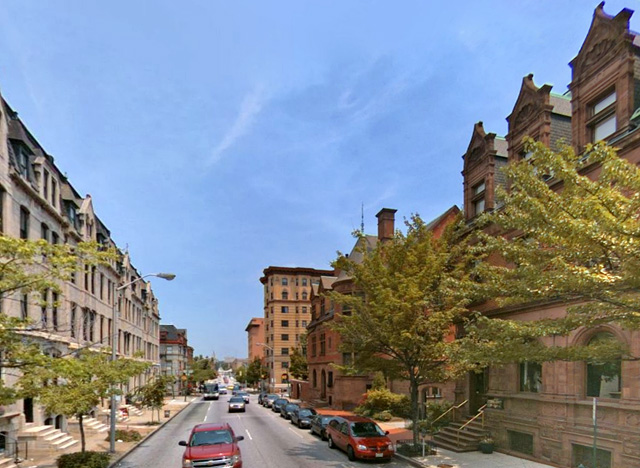
Mount Vernon was once the heart of affluent Baltimore, host to the city's elite and their elegant mansions. Sadly, that is no longer the case. Today, both Bolton Hill and Federal Hill are more exclusive and more impressive architecturally. Except for the area surrounding the 1829 54 meter high Washington Monument, much of the neighborhood has not survived unscathed through post-war urban renewal. Parking lots now dominate many blocks, stark testament to the dominance of the automobile in the past 50 years. I've seen Mount Vernon described as a residential neighborhood, but that's a hard case to make. Pockets of residences certainly do exist, a few blocks here and there, but much of the area's one-time homes have given way to alternate uses. Around the parks surrounding the monument, then as now the best addresses in the area, very few buildings are still in use as residences. Most now house institutions, clubs, offices, etc. On surrounding blocks are libraries, universities, schools, shops, galleries, museums, banks, and performance spaces. In short, it's the cultural heart of the city. Rowhomes have been converted into offices for lawyers, publishing firms, architects, and fund managers. The publishing company Agora occupies several historical buildings in Mount Vernon. The multitude of businesses have spawned a market for lunchtime cafes and restaurants and afterwork bars and clubs. This has left little room for homes, but nonetheless there's plenty of good examples of streetscapes. The borders of the neighborhood are roughly Franklin Street on the south edge, Jones Fall Expressway east, Eager Street north, and probably Howard west. The Midtown-Belvedere neighborhood, which stretches northward from Mount Vernon to Mt Royal Avenue, is often included as part of the neighborhood so I also feature images from there.














 |
| The commercial south end of Charles Street |
 |
| Read Street, a potentially charming area but unfortunately surrounded by neglect |
 |
| Now home to Agora, the Ross Winans House was once described by the NYTimes as the finest home south of New York |











It's never good in a city to have a sense that land is cheap enough to not do anything with it. One of Manhattan's greatest assets is that sense of energy on almost every street corner. Land is too expensive to just let it sit there. In Mount Vernon, however, parking lots are everywhere. Parking lots are perhaps the last use one wants to see on a city lot. They're such a black hole of activity, and hideous. And they're a depressing reminder of the devastation of urban renewal (certainly one of history's greatest misnomers). I'm intrigued to see how Mount Vernon evolves in the years to come, but I worry whatever efforts are taken will be too little too late. A lot would have to be done to regain this neighborhood. As one commenter put it, the entirety of the upper middle-class population who once lived here moved out many years ago, and it'll certainly be a struggle to get them back.

















































